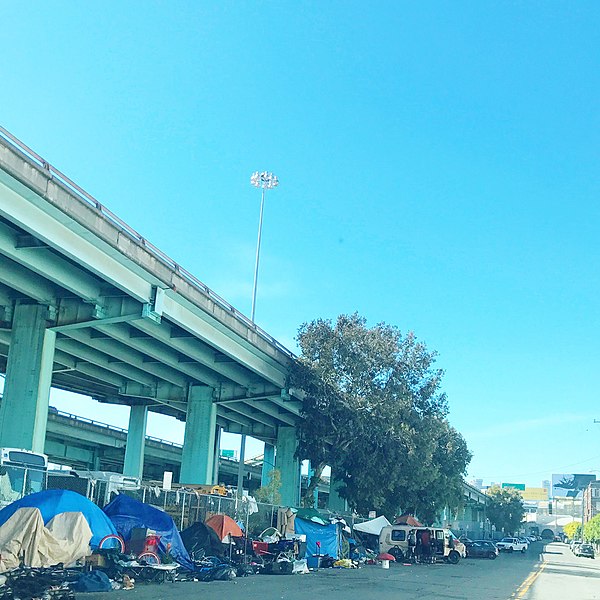Homelessness in California
The United States Department of Housing and Urban Development estimated that more than 181,399 people were experiencing homelessness in California in January 2023. This represents more than 27% of the homeless population of the United States even though California has slightly less than 12% of the country's total population, and is one of the highest per capita rates in the nation, with 0.46% of residents being homeless. More than two-thirds of homeless people in California are unsheltered, which is the highest percentage of any state in the United States. 49% of the unsheltered homeless people in the United States live in California: about 123,423 people, which is eight times as many as the state with the second highest total. Even those who are sheltered are so insecurely, with 90% of homeless adults in California reporting that they spent at least one night unsheltered in the past six months.

A tent city on East 12th Street in Oakland, California, set up by local homeless people, 2019
Homeless man in Fresno, California, 2019
Clifton Hall, a former dormitory at California College of the Arts, was bought by the city of Oakland using Homekey funds and converted to public housing for people experiencing homelessness.
Tents of the homeless on the sidewalk in Skid Row, Los Angeles, 2018
Homelessness in the San Francisco Bay Area
The San Francisco Bay Area comprises nine northern California counties and contains five of the ten most expensive counties in the United States. Strong economic growth has created hundreds of thousands of new jobs, but coupled with severe restrictions on building new housing units, it has resulted in an extreme housing shortage which has driven rents to extremely high levels. The Sacramento Bee notes that large cities like San Francisco and Los Angeles both attribute their recent increases in homeless people to the housing shortage, with the result that homelessness in California overall has increased by 15% from 2015 to 2017. In September 2019, the Council of Economic Advisers released a report in which they stated that deregulation of the housing markets would reduce homelessness in some of the most constrained markets by estimates of 54% in San Francisco, 40 percent in Los Angeles, and 38 percent in San Diego, because rents would fall by 55 percent, 41 percent, and 39 percent respectively. In San Francisco, a minimum wage worker would have to work approximately 4.7 full-time jobs to be able to spend less than 30% of their income on renting a two-bedroom apartment.

Homeless person on Church Street in San Francisco
Homeless tents under the freeway in San Francisco, 2017
Homeless person in front of a parked Tesla in the Mission District in 2022.
A small tent city under an overpass carrying Interstate 580 in Oakland








